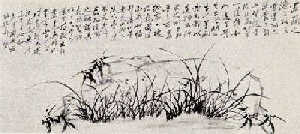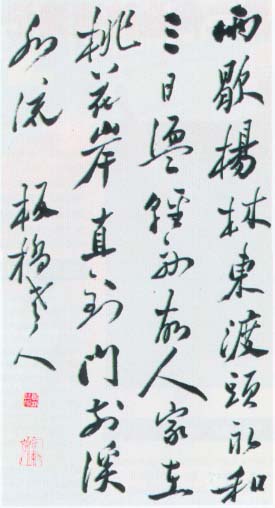Zheng Xie (1693-1765), commonly known
as Zheng Banqiao, was a native of Xinghua, Jiangsu Province.
Born into a poor family, Zheng lived with his wet nurse at a very young age. He
learned to paint during his childhood from his father, and then made a living
selling his paintings. With support from his friends, Zheng later got the
opportunity to study and took part in the imperial examination in the county and
province. Zheng ranked the most successful candidate in the highest imperial
examination and later served as a county magistrate in Shandong Province. During his 12 years as an official,
Zheng gained the respect of many people. However, unwilling to yield to the
philistine ways of the official circle, he later resigned. Zheng then lived in
Yangzhou selling his paintings to earn a living. He expressed his true feelings
in paintings and gained high achievements.
 Zheng was good at drawing orchids, bamboo and
stones. Drawing from the styles of Xu Wei, Shi Tao, Ba Da and other famous
painters, Zheng was adept in Xie Yi (freehand) ink and wash and raised
the theory of the three steps of painting -- having bamboo in one's eyes, hands
and heart. Bamboo in Zheng's paintings was the embodiment of his thoughts and
character. His technique involved both dry-brush and
wet-brush stroke, including forceful strokes. Zheng stressed the
combination of poetry, calligraphy and painting, adding lines from poems to his
paintings to bring out the themes. This theory became a
feature of the scholar painting.
Zheng was good at drawing orchids, bamboo and
stones. Drawing from the styles of Xu Wei, Shi Tao, Ba Da and other famous
painters, Zheng was adept in Xie Yi (freehand) ink and wash and raised
the theory of the three steps of painting -- having bamboo in one's eyes, hands
and heart. Bamboo in Zheng's paintings was the embodiment of his thoughts and
character. His technique involved both dry-brush and
wet-brush stroke, including forceful strokes. Zheng stressed the
combination of poetry, calligraphy and painting, adding lines from poems to his
paintings to bring out the themes. This theory became a
feature of the scholar painting.
Zheng's calligraphy and paintings were of a
high artistic value. Learning from Huang Tingjian at first, Zheng later created
a new style by combining the orchid-line drawing with calligraphy. His strokes
sometimes were as graceful as orchid leaves or as forceful as bamboo
leaves.
Apart from painting and calligraphy, Zheng
was very fond of literature. Many of his works of literature were about the
lives of ordinary people, told in a simple and natural
style.


